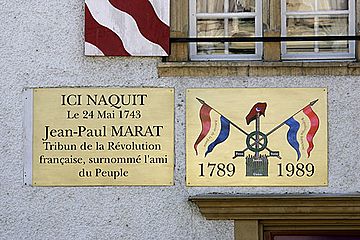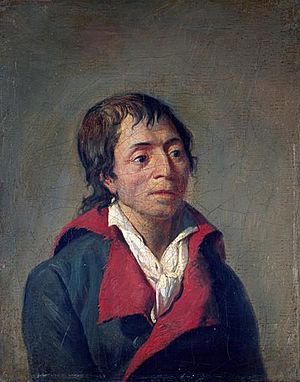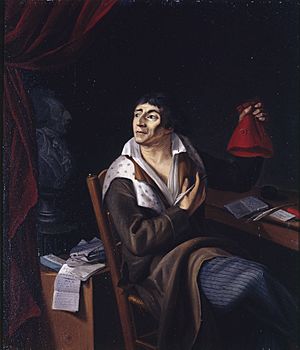Jean-Paul Marat facts for kids
Quick facts for kids
Jean-Paul Marat
|
|
|---|---|

Jean-Paul Marat by Joseph Boze, 1793, Carnavalet Museum
|
|
| Born | 24 May 1743 |
| Died | 13 July 1793 (aged 50) |
| Cause of death | Assassination |
| Alma mater | University of St. Andrews, MD |
| Occupation | Journalist, politician, physician, scientist |
| Political party | Jacobin Club (1789–1790) Cordeliers Club (1790–1793) |
| Spouse(s) | fr: Simone Evrard |
| Parent(s) | Jean Mara, Louise Cabrol |
Jean-Paul Marat (24 May 1743 – 13 July 1793) was a French political theorist, physician, and scientist who became best known for his role as a radical journalist and politician during the French Revolution. His journalism became renowned for its fierce tone towards the new leaders and institutions of the revolution, and the advocacy of basic human rights for the poorest members of society, yet calling for prisoners of the Revolution to be killed before they could be freed in what became known as the September Massacres. He was one of the most radical voices of the French Revolution.
Contents
Early life, education, and early writing
Family
Jean-Paul Marat was born in Boudry, now a canton of Switzerland, on 24 May 1743. He was the first of five children born to Jean Mara (born Juan Salvador Mara; 1704–1783), a Sardinian from Cagliari of Spanish descent, and Louise Cabrol (1724–1782), from Geneva.
Marat's family lived in moderate circumstances, as his father was well educated but unable to secure a stable profession. Marat credits his father for instilling in him a love of learning. He explains he felt "exceptionally fortunate to have had the advantage of receiving a very careful education in my paternal home." From his mother, he claims to have been taught a strong sense of morality and social conscience. Marat left home at the age of 16, desiring to seek an education in France. He was aware of the limited opportunities for those seen as outsiders as his highly educated father had been turned down for several college (secondary) teaching posts. In 1754 his family settled in Neuchâtel, capital of the Principality, where Marat's father began working as a tutor.
Education
Marat received his early education in the city of Neuchâtel. He then moved to Paris and studied medicine without gaining any formal qualifications. After moving to France, Jean-Paul Mara francized his surname as "Marat". He worked, informally, as a doctor after moving to London in 1765. Highly ambitious, but without patronage or qualifications, he set about inserting himself into the intellectual scene.
Political, philosophical, and medical writing
His first political work Chains of Slavery was completed in 1774. In the work, Marat criticized aspects of England's constitution that he believed to be corrupt or despotic. He condemned the King's power to influence Parliament through bribery and attacked limitations on voting rights. Chains of Slavery's political ideology takes clear inspiration from Jean-Jacques Rousseau by attributing the nation's sovereignty to the common people rather than a monarch. This work earned him honorary membership of the patriotic societies of Berwick-upon-Tweed, Carlisle and Newcastle.
Marat published "A Philosophical Essay on Man," in 1773 and "Chains of Slavery," in 1774.
He published Enquiry into the Nature, Cause, and Cure of a Singular Disease of the Eyes on his return to London. In 1776, Marat moved to Paris after stopping in Geneva to visit his family.
In Paris, his growing reputation as a highly effective doctor along with the patronage of the Marquis de l'Aubespine (the husband of one of his patients) secured his appointment as physician to the bodyguard of the Comte d'Artois, Louis XVI's youngest brother who was to become king Charles X in 1824. He began this position in June 1777. The position paid 2,000 livres a year plus allowances.
Scientific writing
Marat set up a laboratory in the Marquise de l'Aubespine's house with funds obtained by serving as court doctor among the aristocracy. His method was to describe in detail the meticulous series of experiments he had undertaken on a problem, seeking to explore and then exclude all possible conclusions but the one he reached.
He published works on fire and heat, electricity, and light. He published a summary of his scientific views and discoveries in Découvertes de M. Marat sur le feu, l'électricité et la lumière (English: Mr Marat's Discoveries on Fire, Electricity and Light) in 1779. He published three more detailed and extensive works that expanded on each of his areas of research.
Recherches Physiques sur le Feu
The first of Marat's large-scale publications detailing his experiments and drawing conclusions from them was Recherches Physiques sur le Feu (English: Research into the Physics of Fire), which was published in 1780 with the approval of the official censors.
This publication describes 166 experiments conducted to demonstrate that fire was not, as was widely held, a material element but an "igneous fluid."
Découvertes sur la Lumière
In Marat's time, Newton's views on light and colour were regarded almost universally as definitive, yet Marat's explicit purpose in his second major work Découvertes sur la Lumière (Discoveries on Light) was to demonstrate that in certain key areas, Newton was wrong.
The focus of Marat's work was the study of how light bends around objects, and his main argument was that while Newton held that white light was broken down into colours by refraction, the colours were actually caused by diffraction. When a beam of sunlight shone through an aperture, passed through a prism and projected colour onto a wall, the splitting of the light into colours took place not in the prism, as Newton maintained, but at the edges of the aperture itself. Marat sought to demonstrate that there are only three primary colours, rather than seven as Newton had argued.
Recherches Physiques sur L'Électricité
Marat's third major work, Recherches Physiques sur l'Électricité (English: Research on the Physics of Electricity), outlined 214 experiments. One of his major areas of interest was in electrical attraction and repulsion. Repulsion, he held, was not a basic force of nature. He addressed a number of other areas of enquiry in his work, concluding with a section on lightning rods which argued that those with pointed ends were more effective than those with blunt ends, and denouncing the idea of "earthquake rods" advocated by Pierre Bertholon de Saint-Lazare. This book was published with the censor's stamp of approval, but Marat did not seek the endorsement of the Academy of Sciences.
In April 1783, he resigned his court appointment and devoted his energies full-time to scientific research. Apart from his major works, during this period Marat published shorter essays on the medical use of electricity (Mémoire sur l'électricité médicale (1783)) and on optics (Notions élémentaires d'optique (1784)). He published a well-received translation of Newton's Opticks (1787), which was still in print until recently, and later a collection of essays on his experimental findings, including a study on the effect of light on soap bubbles in his Mémoires académiques, ou nouvelles découvertes sur la lumière (Academic memoirs, or new discoveries on light, 1788). Benjamin Franklin visited him on several occasions and Goethe described his rejection by the Academy as a glaring example of scientific despotism.
Other pre-Revolutionary writing
In 1780, Marat published his "favourite work," a Plan de législation criminelle. The work contained many radical ideas, including the argument that society should provide fundamental natural needs, such as food and shelter, if it expected all its citizens to follow its civil laws, that the king was no more than the "first magistrate" of his people, that there should be a common death penalty regardless of class, and that each town should have a dedicated "avocat des pauvres" and set up independent criminal tribunals with twelve-man juries to ensure a fair trial.
The French Revolution
In August 1789, Marat published La Constitution, ou Projet de déclaration des droits de l'homme et du citoyen, intended to influence the drafting of France's new constitution, then being debated in the National Assembly. In this work, he builds his theories upon ideas taken from Montesquieu and Rousseau, claiming that the sovereignty of the nation rests with the people and emphasizing the need for a separation of powers. He argues for a constitutional monarchy, believing that a republic is ineffective in large nations. Marat's work elicited no response from the National Assembly.
On 12 September 1789, Marat began his own newspaper, entitled Publiciste parisien, before changing its name four days later to L'Ami du peuple ("The People's friend"). From this position, he often attacked the most influential and powerful groups in Paris as conspirators against the Revolution, including the Commune, the Constituent Assembly, the ministers, and the Châtelet.
Between 1789 and 1792, Marat was often forced into hiding, sometimes in the Paris sewers, where he almost certainly aggravated his debilitating chronic skin disease (possibly dermatitis herpetiformis). In January 1792, he married the 26-year-old Simone Evrard in a common-law ceremony on his return from exile in London, having previously expressed his love for her. She was the sister-in-law of his typographer, Jean-Antoine Corne, and had lent him money and sheltered him on several occasions.
As the Paris Commune achieved more influence, it formed a Committee on Surveillance which included Marat, Jacque-Nicolas Billaud-Varennes, Jean-Marie Collot d'Herbois, Georges Danton, Jean-Lambert Tallien, Panis (fr) and David. The Committee, of which Marat was one of the most influential members, took the step of withdrawing from the prisons those of whose guilt, in its opinion, there was any reasonable doubt. Forty-eight hours later, the notorious September massacres began.
On 3 September, the second day of the massacres, the Committee of Surveillance of the Commune published a circular that called on provincial Patriots to defend Paris and asked that, before leaving their homes, they eliminate counter-revolutionaries. Authored by Marat as head of the Committee, signed by him and circulated to the provinces, it hailed the rounding up and killing of political enemies going on in Paris as a model for the provinces.
Marat was elected to the National Convention in September 1792 as one of 26 Paris deputies, although he belonged to no party. When France was declared a Republic on 22 September, Marat renamed his L'Ami du peuple as Le Journal de la République française ("Journal of the French Republic"). His stance during the trial of the deposed king Louis XVI was unique. He declared it unfair to accuse Louis of anything before his acceptance of the French Constitution of 1791, and although implacably, he said, believing that the monarch's death would be good for the people, defended the King calling him a "wise and respected old man").
On 21 January 1793, Louis XVI was guillotined, which caused political turmoil. From January to May, Marat fought bitterly with the Girondins, whom he believed to be covert enemies of republicanism. Marat's hatred and suspicion of the Girondins became increasingly heated which led him to call for the use of violent tactics against them. He cried that France needed a chief, "a military Tribune". The Girondins fought back and demanded that Marat be tried before the Revolutionary Tribunal. After trying to avoid arrest for several days, Marat was finally imprisoned. On 24 April, he was brought before the Tribunal on the charges that he had printed in his paper statements calling for widespread murder as well as the suspension of the Convention. Marat decisively defended his actions, stating that he had no evil intentions directed against the Convention. Marat was acquitted of all charges to the celebration of his supporters.
Death
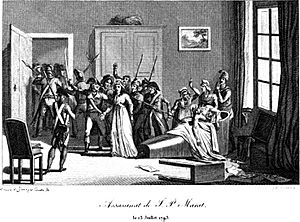
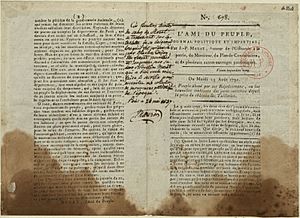
Marat was assassinated by Charlotte Corday, while taking a medicinal bath for his debilitating skin condition. In death, Marat became an icon to the Jacobins as a revolutionary martyr, as portrayed in Jacques-Louis David's famous painting, The Death of Marat. For this assassination, Corday was executed four days later, on 17 July 1793. During her four-day trial, she testified that she had carried out the assassination alone, saying "I killed one man to save 100,000."
See also
 In Spanish: Jean-Paul Marat para niños
In Spanish: Jean-Paul Marat para niños


